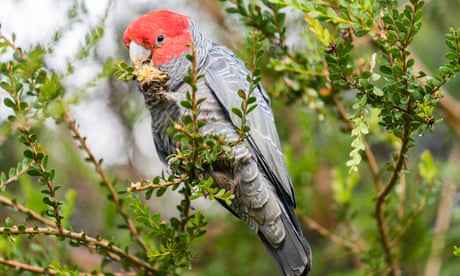Extract from The Guardian
Once-in-a-decade study finds 216 out of 1,299 species are in danger – up from 195 in 2011.

The action plan for birds is a major scientific study led by Stephen Garnett of Charles Darwin University, with input from more than 300 bird experts.
It finds 216 out of 1,299 species are threatened – up from 195 in 2011 – with the climate crisis pushing more birds on to the list or increasing the threat status of those in danger.
Among them are 17 birds found in cooler, high-elevation rainforests in Queensland that either appear on the list for the first time or are now more threatened than they were a decade ago.

They include the fernwren, a little brown bird with a loud voice, whose numbers have declined by 57% since 2000, pushing the species from near-threatened status to endangered.
Sean Dooley, of BirdLife Australia, said it was estimated there were 6 million fewer individuals across those 17 species than there were in 2011 and “that is almost unequivocally due to climate change”.
“What really stands out from the action plan is how quickly climate change is impacting our birds,” he said.
In New South Wales, eight birds were found to have become more threatened as a result of the 2019-20 bushfires, including the rufous scrub-bird and the south-eastern glossy black-cockatoo.
The action plan examines the state of Australia’s birdlife, how individual species are faring, what actions can be taken to halt and reverse declines and where there have been conservation successes.
The plan considered 1,299 bird species and found the Mukarrthippi grasswren, a subspecies of striated grasswren that lives in the central west of NSW, had the lowest population numbers of any Australian bird. The subspecies was only formally declared last year and the plan estimates there are as few as three pairs remaining.
Another bird, the grey range thick-billed grasswren found in western NSW, was found to have greater numbers as a result of increased monitoring effort sparked by the previous action plan, but its population is still estimated to be only 50 to 60 individuals.
Of the 216 in-danger species, two are possibly extinct, 21 are critically endangered, 74 are endangered, 87 are vulnerable and 32 are near-threatened.
The report finds 96 species are faring worse than a decade ago and require listing in a higher threat category. There were 23 birds whose conservation status was found to have improved and could be downlisted.
Garnett said the report could be summarised as “mixture of concern we’re going to lose some animals” but it also showed “we don’t have to give up, there’s a lot we can do to make difference”.
He said the independent threatened species scientific committee, which advises the federal government, was already assessing some of the birds the plan recommended for a threatened listing and the Mukarrthippi grasswren had been recommended for a critically endangered listing under NSW laws.
The plan lays out actions – such as improved fire management and removal of predators – that can be taken to improve the trajectory for different species.
Garnett said there were several birds on King Island off Tasmania, including the King Island brown thornbill and the King Island scrubtit, whose numbers would improve if land clearing ceased on the island.
The report highlights species where focused conservation measures have led to improved population numbers, including for the Norfolk Island green parrot, which moved from critically endangered down to vulnerable as a result of work to protect their nests.
“The results tell us clearly that without changes, many species will continue to decline or to be lost altogether,” said.
“However, within our report we also have some clear instructions on how to avoid these outcomes. The 2020 report also illustrates how conservation action can turn things around when well-resourced and implemented.”
No comments:
Post a Comment